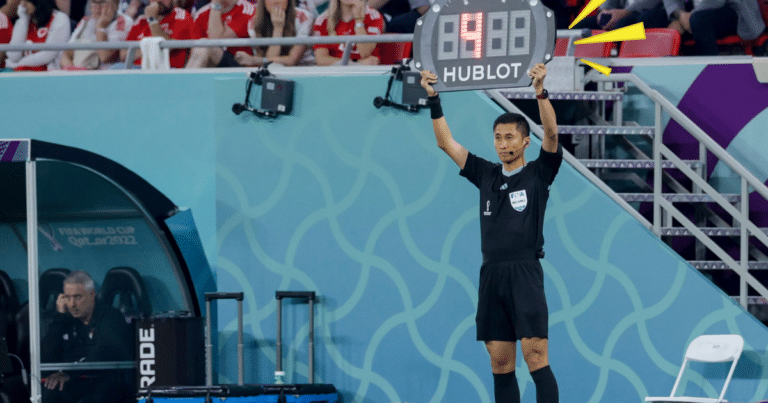Out of Bounds in Soccer: What You Need to Know

When a ball goes out of bounds in soccer, a few things can happen including a throw-in, a goal kick, or a corner kick.
In soccer, the field of play is surrounded by boundary lines, and if the ball crosses over these lines, it is considered out of bounds. This rule is essential to ensure fair play and maintain the integrity of the game.
Key Takeaways From This Article:
- A soccer field is a rectangle. If 100% of the soccer ball goes over the lines, it is considered out of bounds.
- A player can be outside the lines while the ball is still in play.
- If the soccer ball is partially out of bounds, it is still in play.
- If the soccer ball crosses the painted lines in the air, it is considered out of bounds but more subjective.
Knowing these rules is essential for players, coaches, and fans to understand the game’s flow and strategy!
Understanding Out of Bounds in Soccer

Out of bounds, also called the touchline, goal line, or sideline, is a fundamental term in soccer.
It refers to the area outside the field of play, where the ball is considered out of play.
In soccer, the field of play is rectangular, with two touchlines and two goal lines. The touchlines run along the longer sides of the field, while the goal lines run along the shorter sides.
When the ball crosses the touchline, either on the ground or in the air, it is considered out of bounds, and play stops. Take a look at this video to see an example for yourself.
Subsequently, the game restarts with a throw-in, corner kick, or goal kick, depending on which team touched the ball last and the situation.
The Role of Sidelines and Goal Lines
Sidelines in Soccer
The sidelines in soccer play a crucial role in determining whether a ball is in or out of bounds.
The sidelines run along the length of the field and are marked with white lines. The ball is considered out of bounds if it completely crosses over the sideline, whether it is in the air or on the ground.

When the ball goes out of bounds, the opposing team is awarded a throw-in from the spot where the ball went out. This is an opportunity for the team to regain possession of the ball and potentially create a scoring opportunity.
Goal Lines in Soccer
The goal lines are the lines that run across the width of the field at each end, marking the boundaries of the goal area.
Again, the ball must completely cross the goal lines to be deemed out of bounds.
When the ball goes out of bounds over the goal line, the opposing team is awarded a goal kick. The goalkeeper takes the goal kick from within the goal area and must kick the ball beyond the penalty area.
If the defensive team lasts touches the ball and it goes out of bounds along the goal line, the offensive team is awarded a corner kick.
Key Strategies to Avoid The Ball Going Out of Bounds

When playing soccer, it is important to keep the ball in play and avoid out of bounds. Here are some key strategies that can help you avoid the soccer ball going out of bounds:
1. Be aware of the field boundaries
Awareness is everything. Knowing the boundaries of the field is essential to avoid turning the ball over to the other team.
Make sure you are familiar with the field markings, including the sidelines, goal lines, and corner arcs.
One thing I see a lot in youth soccer is players not understanding the markings because they are either on an American football field or a condensed 11v11 field. During warmups, I would just notice where the corner flags are. This gives you a target where the goal line and sideline meet. From here, just notice the color that the lines are. On a full field, they should be white but on a smaller field, they may be another color like red or blue.
Keep your eyes on the ball and the field at all times, so you can react quickly if the ball goes out of bounds.
2. Use proper footwork
Using proper footwork can help you keep the ball in play and avoid out of bounds. Use the inside of your foot to control the ball and make short, accurate passes.
When dribbling, use quick, light touches to keep the ball close to your feet. Avoid using long touches along the sideline as the ball can get away from you and cause a turnover.
3. Communicate with your teammates
Let your teammates know where you are on the field and where you want the ball.
Call out to your teammates if you see the ball heading towards the sidelines or goal line, so they can react quickly and keep the ball in play.
4. Anticipate the ball’s movement
Anticipating the ball’s movement can help you avoid going out of out of bounds while maintaining position.
Watch the ball and the players around you, and try to anticipate where the ball will go next. Position yourself accordingly, so you can intercept the ball or make a quick pass to keep it in play.
5. Stay focused and stay in control
Staying focused and in control is key to avoiding turnovers.
Always be scanning the field and try to avoid distractions from the parents, fans, or other players.
Stay cool, calm, and collected, and avoid making rushed or panicked decisions that can cause the ball to go out of bounds.
Frequently Asked Questions
What is the out of bounds rule in soccer?
The out of bounds rule in soccer dictates that if the ball completely crosses the touchline or the goal line, it is out of bounds, and play stops. The opposing team will then be awarded a throw-in, corner kick, or goal kick, depending on where the ball went out of bounds.
What to do if a soccer ball goes out of bounds?
If the ball goes out of bounds on the sideline, the opposing team will be awarded a throw-in.
If the ball went out of bounds over the goal line and was last touched by an attacking player, the opposing team will be awarded a goal kick.
If it was last touched by a defending player and it goes out of bounds over the goal line, the opposing team will be awarded a corner kick.
Can a soccer player be out of bounds?
Yes, a soccer player can be out of bounds. If any part of a player’s body, except for their hands and arms, is over the touchline or goal line, they are considered out of bounds but play resumes.
A dead ball call will be whistled or played when the ball, not the player is out of bounds.
When is the ball out of bounds in soccer?
The ball is out of bounds in soccer when it completely crosses the touchline or the goal line. If the ball touches the line, it is still considered in play. This is the same for goals…the entire ball needs to cross the line.

Written By: Beau Bridges
Beau is the founder of SoccerNovo, dedicated to helping players and parents navigate the youth soccer landscape. As a former youth coach and soccer parent, he shares insights on player development, recruiting, and the ever-evolving soccer scene in the U.S.
Let’s connect




